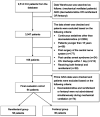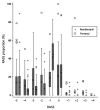Remifentanil provides an increased proportion of time under light sedation than fentanyl when combined with dexmedetomidine for mechanical ventilation
- PMID: 33745360
- PMCID: PMC7989131
- DOI: 10.1177/03000605211002683
Remifentanil provides an increased proportion of time under light sedation than fentanyl when combined with dexmedetomidine for mechanical ventilation
Abstract
Objective: To compare the effects of remifentanil versus fentanyl during light sedation with dexmedetomidine in adults receiving mechanical ventilation (MV) in the intensive care unit.
Methods: In this retrospective cohort study, we compared the use of remifentanil versus fentanyl in adults receiving MV with dexmedetomidine sedation. The primary outcome was the proportion of time under light sedation (Richmond Agitation-Sedation Scale score between -1 and 0) during MV.
Results: We included 94 patients and classified 58 into the remifentanil group and 36 into the fentanyl group. The mean proportion of time under light sedation during MV was 66.6% ± 18.5% in the remifentanil group and 39.9% ± 27.3% in the fentanyl group. In the multivariate analysis with control for confounding factors, patients in the remifentanil group showed a significantly higher proportion of time under light sedation than patients in the fentanyl group (mean difference: 24.3 percentage points; 95% confidence interval: 12.9-35.8).
Conclusions: Remifentanil use might increase the proportion of time under light sedation in patients receiving MV compared with fentanyl administration.
Keywords: Light sedation; dexmedetomidine; fentanyl; mechanical ventilation; opioid; remifentanil.
Conflict of interest statement
Figures


Similar articles
-
[Methohexital for analgosedation of ventilated intensive care patients : prospective nonrandomized single center observational study on incidence of delirium].Anaesthesist. 2014 Jun;63(6):488-95. doi: 10.1007/s00101-014-2317-8. Epub 2014 May 14. Anaesthesist. 2014. PMID: 24820355 German.
-
Safety and efficacy of analgesia-based sedation with remifentanil versus standard hypnotic-based regimens in intensive care unit patients with brain injuries: a randomised, controlled trial [ISRCTN50308308].Crit Care. 2004 Aug;8(4):R268-80. doi: 10.1186/cc2896. Epub 2004 Jun 28. Crit Care. 2004. PMID: 15312228 Free PMC article. Clinical Trial.
-
[Remifentanil for analgesia and sedation in mechanically ventilated patients in intensive care unit].Zhonghua Wei Zhong Bing Ji Jiu Yi Xue. 2013 Mar;25(3):167-70. Zhonghua Wei Zhong Bing Ji Jiu Yi Xue. 2013. PMID: 23798067 Clinical Trial. Chinese.
-
Analgosedation: a paradigm shift in intensive care unit sedation practice.Ann Pharmacother. 2012 Apr;46(4):530-40. doi: 10.1345/aph.1Q525. Epub 2012 Apr 10. Ann Pharmacother. 2012. PMID: 22496477 Review.
-
Dexmedetomidine versus propofol sedation in reducing delirium among older adults in the ICU: A systematic review and meta-analysis.Eur J Anaesthesiol. 2020 Feb;37(2):121-131. doi: 10.1097/EJA.0000000000001131. Eur J Anaesthesiol. 2020. PMID: 31860605
Cited by
-
Effects of fentanyl administration in mechanically ventilated patients in the intensive care unit: a systematic review and meta-analysis.BMC Anesthesiol. 2022 Oct 21;22(1):323. doi: 10.1186/s12871-022-01871-7. BMC Anesthesiol. 2022. PMID: 36271330 Free PMC article.
-
Efficacy of Remifentanil in Patients Undergoing Cardiac Surgery: A Systematic Review and Network Meta-Analysis.Cureus. 2023 Dec 29;15(12):e51278. doi: 10.7759/cureus.51278. eCollection 2023 Dec. Cureus. 2023. PMID: 38161541 Free PMC article. Review.
-
Remifentanil Versus Fentanyl in Critically Ill Patients Requiring Mechanical Ventilation: A Single-Center Retrospective Cohort Study.Cureus. 2025 Jul 13;17(7):e87804. doi: 10.7759/cureus.87804. eCollection 2025 Jul. Cureus. 2025. PMID: 40661821 Free PMC article.
-
Comparative efficacy of remifentanil and fentanyl in mechanically ventilated ICU patients: a systematic review and meta-analysis on ventilation duration and delirium incidence.J Anesth Analg Crit Care. 2025 Jun 22;5(1):32. doi: 10.1186/s44158-025-00258-7. J Anesth Analg Crit Care. 2025. PMID: 40544288 Free PMC article.
-
Modern Sedation and Analgesia Strategies in Neurocritical Care.Curr Neurol Neurosci Rep. 2023 Apr;23(4):149-158. doi: 10.1007/s11910-023-01261-7. Epub 2023 Mar 7. Curr Neurol Neurosci Rep. 2023. PMID: 36881257 Review.
References
-
- Devlin JW, Skrobik Y, Gélinas C, et al.. Clinical Practice Guidelines for the Prevention and Management of Pain, Agitation/Sedation, Delirium, Immobility, and Sleep Disruption in Adult Patients in the ICU. Crit Care Med 2018; 46: e825–e873. - PubMed
-
- Romagnoli S, Amigoni A, Blangetti I, et al. . Light sedation with dexmedetomidine: a practical approach for the intensivist in different ICU patients. Minerva Anestesiol 2018; 84: 731–746. - PubMed
-
- Shehabi Y, Howe BD, Bellomo R, et al.. Early Sedation with Dexmedetomidine in Critically Ill Patients. N Engl J Med 2019; 380: 2506–2517. - PubMed
-
- Rosow CE. An overview of remifentanil. Anesth Analg 1999; 89: S1–S3. - PubMed
MeSH terms
Substances
LinkOut - more resources
Full Text Sources
Other Literature Sources

